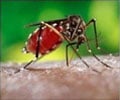Scientists have discovered why some people are less prone to malaria. The people with a specific type of hemoglobin — the oxygen-carrying molecule
Scientists have discovered why some people are less prone to malaria. The people with a specific type of hemoglobin — the oxygen-carrying molecule that gives red blood cells their color — are less prone to severe malaria. In a series of experiments, the researchers determined how hemoglobin type C impairs the ability of malaria parasites to cause disease symptoms.
“This research gives us a new insight into malaria, a major global killer that preys especially on young children and claims a life every 30 seconds,” notes Anthony S. Fauci, M.D., director of the National Institute of Allergy and Infectious Diseases (NIAID), part of the National Institutes of Health, where the research was conducted.“If we better understand the natural protective mechanisms against malaria, we might be able to mimic that protective effect through vaccines or drugs,” says NIAID researcher Thomas E. Wellems, M.D., Ph.D., whose team’s findings appear this week in the journal Nature.
Nature has probably mutated the hemoglobin gene to protect the people from malaria in endemic regions. Hemoglobin exists in several varieties. Hemoglobin A is the most common, but in parts of West Africa, where malaria is rife, one-fourth of the population has at least one gene for hemoglobin C. Children with at least one hemoglobin C gene are less prone to deadly cerebral malaria, in which parasite-infected red blood cells accumulate in the brain. But the mystery is how does hemoglobin C confers this protection to the person. To solve the mystery, Dr. Wellems and his colleagues studied laboratory-infected red blood cells and blood drawn from children with malaria from the African nation of Mali and studied three phenenomenon and found how well parasitized red blood cells can be made to stick to one another, to uninfected red blood cells and to blood vessel walls. These phenomena — known respectively as agglutination, rosetting and cytoadherence — all depend on a parasite protein called PfEMP-1.
To evade the immune system, the malarial parasites produce proteins, including PfEMP-1, that remodel the red blood cell’s surface to their advantage. For example, when spikes of PfEMP-1 are distributed evenly over the surface of an infected AA red blood cell, they act like grappling hooks, allowing the parasitized cells to stick in tiny capillaries and avoid being cleared from the bloodstream. When parasite-infected red blood cells stick to blood vessel walls, the resulting inflammation may increase the severity of malarial symptoms, explains Dr. Wellems.
Dr. Wellems and his colleagues found uneven and reduced distribution of PfEMP-1 on the surface of parasite-infected red blood cells from children with at least one hemoglobin C gene. This abnormal distribution of PfEMP-1 significantly impairs the infected cells’ “stickiness.” For instance, laboratory-grown, parasitized AC blood cells agglutinated at a 75 percent lower rate than did AA red blood cells, while parasitized CC blood cells did not stick to each other at all. Rosette formation, in which parasitized cells attach to non-parasitized cells, also occurred significantly less often with AC and CC blood cells than with AA blood cells. Rosettes can impede blood flow in small vessels of the brain, contributing to cerebral malaria and death, notes Dr. Wellems. The scientists showed that AA cells often stick to blood vessel walls, whereas this occurs much less often with both AC and CC blood cells.
Together, the data from Dr. Wellems’ team may explain why red blood cells containing hemoglobin C are less hospitable to malaria parasites than normal AA red blood cells. For people with at least one gene for hemoglobin C, the result is less severe malaria.
Advertisement









